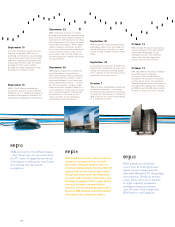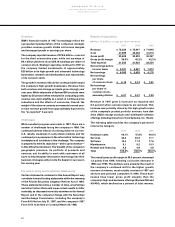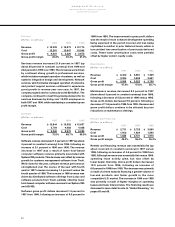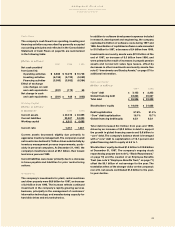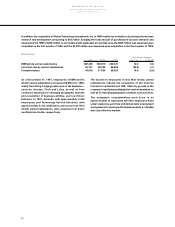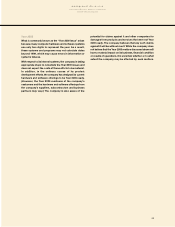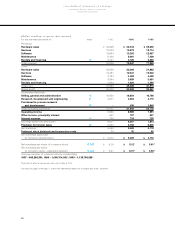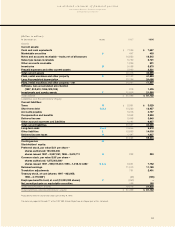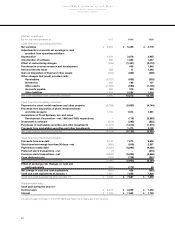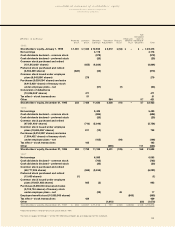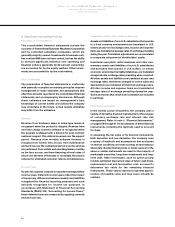IBM 1997 Annual Report Download - page 46
Download and view the complete annual report
Please find page 46 of the 1997 IBM annual report below. You can navigate through the pages in the report by either clicking on the pages listed below, or by using the keyword search tool below to find specific information within the annual report.
Currency had an approximately 6 percentage point
negative impact on the company’s revenue results in the
fourth quarter. At constant currency in the fourth quarter
of 1997, Asia Pacific revenue would have increased about
10 percent, European revenue would have grown
approximately 5 percent and revenue from Canada would
have increased about 19 percent.
Total hardware sales declined 1.3 percent year over year
to $11.5 billion. RS/6000, storage and semiconductor
revenue increased, while overall personal computer,
AS/400 and System/390 revenue declined. On a constant
currency basis, hardware sales increased in all key
hardware lines, except for System/390 and consumer
personal computers.
Services revenue totaled $5.9 billion, a 17.5 percent
increase compared to the year-earlier period. Approx-
imately $8.5 billion in new services contracts was signed
in the quarter. Services margins were essentially flat year
over year at 22.5 percent.
Overall software revenue was $3.8 billion, an increase of
1.4 percent compared with the fourth quarter of 1996.
Maintenance revenue declined 9.2 percent to $1.6 billion
in the fourth quarter when compared with the year-
earlier period, and rentals and financing fell 3.5 percent
to $1.0 billion.
The company’s overall gross profit margin in the fourth
quarter was 40.1 percent, compared to 40.3 percent in
the year-earlier period.
Total fourth-quarter 1997 expenses increased 1.1 percent
year over year. The expense-to-revenue ratio in the fourth
quarter of 1997 was 27.4 percent compared to 27.8 percent
in the year-earlier period.
The company’s tax rate was 30.5 percent in the fourth
quarter, compared to 29.9 percent in the fourth quarter
of 1996.
The company spent approximately $2 billion on share
repurchases in the fourth quarter. The average number of
shares outstanding in the fourth quarter of 1997 was
964.8 million, compared to 1,026.8 million in the year-
earlier period.
Financial Condition
During 1997, the company continued to make significant
investments to fund future growth and increase
shareholder value, expending $6.8 billion for plant, rental
machines and other property, $5.5 billion for research,
development and engineering, and $7.1 billion for the
repurchase of the company’s common shares. The
company had $7.6 billion in cash, cash equivalents and
marketable securities on hand at December 31, 1997.
The company has access to global funding sources.
During 1997, the company issued debt in a variety of
geographies to a diverse set of investors. Significant
funding was issued in the United States, Japan and
Europe. Funding was obtained across the range of debt
maturities, from short-term commercial paper to long-
term debt. More information about company debt is
provided in note G, “Debt,” on page 58.
In December 1993, the company entered into a $10 billion
committed global credit facility to enhance the liquidity
of funds. This facility was amended in February 1997,
and extended to February 2002. As of December 31, 1997,
$9.2 billion was unused and available.
At year-end 1997, the company had an outstanding
balance of $.9 billion of assets under management from
the securitization of loans, leases and trade receivables,
compared to the year-end 1996 level of $1.1 billion. The
company has access to additional funds through securi-
tization, as discussed in note K, “Sale and Securitization
of Receivables,” on page 61.
The rating agencies continued their review of the company’s
financial condition. In January 1997, Standard and Poor’s
revised its outlook on the company and its rated sub-
sidiaries to positive from stable and affirmed its ratings of
senior debt as A, commercial paper as A-1, and preferred
stock as A-.
Moody’s Investors Service rates the senior long-term
debt of the company and its rated subsidiaries as A1,
the commercial paper as Prime-1, and the company’s
preferred stock as “a1.”
Fitch Investors Service rates the company and its rated
subsidiaries’ senior long-term debt as AA-, commercial
paper as F-1+, and preferred stock as A+.
Duff & Phelps rates the company and its rated
subsidiaries’ senior long-term debt as A+, commercial
paper as Duff 1, and the company’s preferred stock as A.
management discussion
International Business Machines Corporation
and Subsidiary Companies
44


